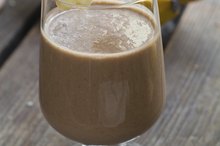Four Components of Nutrition Assessment
Assessing the nutritional status of individuals involves interpreting anthropometric, biochemical, clinical and dietary data. Together the information obtained from these components paints a nutritional picture reflecting health status. The goal of nutrition assessment is to identify malnutrition and nutrition risks, according to guidelines published in a January 2011 issue of the “Journal of Parenteral and Enteral Nutrition.” Diagnosis of nutritional deficiencies and toxicities occur through the assessment process.
Anthropometrics
Anthropometrics refers to body size and composition determination. In clinical settings, measurements such as height, weight and head circumference help identify abnormal growth patterns. Results are compared to standard pre-determined values. Body mass index, or BMI, uses height and weight measurements as the basis for assessing obesity and chronic disease risk. Head circumference measurements indicate potential head and brain development issues in growing infants and children. Tools estimating lean and fat body composition include skinfold thickness, underwater weighing, bioelectrical impedance and air-displacement plethysmography.
Biochemical Data
Audit Tools for Nursing Care Plans
Learn More
Laboratory measurements of nutrients or other chemicals in blood, stool or urine constitute the biochemical component of nutrition assessment. Hemoglobin and ferritin blood tests reflect iron status. Inflammation can be assessed with albumin and C-reactive protein blood levels. Cholesterol and lipoprotein blood test results indicate heart disease risk. Analyzing stool samples may uncover the presence of blood, indicative of abnormal gastrointestinal tract bleeding. Urine sample analysis provides information on diabetes risk, and can alert both patient and healthcare provider to early signs of deteriorating kidney function when high protein levels are present. As with anthropometric tests, comparison of laboratory results to standard values determines if an abnormality exists.
Clinical Methods
A physical exam coupled with a complete medical history aid in malnutrition determination and measurement of its degree of severity. For example, the loss of tooth enamel may indicate frequent vomiting, a sign of bulimia. Visual observation of the presence or loss of normal muscle tone can indicate protein deficiency. Medical chart review and interviews with an individual may uncover past surgical procedures, medication interactions and drug or alcohol use. All play a role in determining nutritional status and subsequent care plan development to improve health.
Dietary
The Kaiser Liquid Diet
Learn More
Analyzing the nutritional adequacy of an individual’s diet provides information relative to fat, protein, carbohydrate, water, vitamin, mineral and fiber intake. Obtained through verbal or written means, individuals review foods eaten during a specified time period, normally 24 hours or three days. A full week's food intake record may be needed for chronic nutritional concerns. Specially designed computer software programs are used for food record analysis, and results are compared to the U. S. Dietary Guidelines or Dietary Reference Intakes. Software programs vary widely, depending upon the different types of foods and nutrients contained in the program’s database. Obtaining information relative to the individual’s habits, cultural background, economic resources and living situation lend further depth to the dietary component of the assessment process.
Related Articles
References
- Journal of Parenteral and Enteral Nutrition: A.S.P.E.N. Guidelines Nutrition Screening, Assessment and Intervention in Adults
- University of Illinois at Chicago: Nutrition Assessment
- Tufts University School of Medicine: Nutrition Asssessment I and II
- Nutrition Assessment; Roberts D. Lee and David C. Nieman
Writer Bio
Sue Roberts began writing in 1989. Her work has appeared in such publications as “Today’s Dietitian” and "Journal of Food Science." Roberts holds a Bachelor of Science in nutrition from Pennsylvania State University, a Master of Public Health in nutrition from the University of Minnesota and a Master of Science in food science from Michigan State University. She is a registered dietitian and certified nutritionist.








